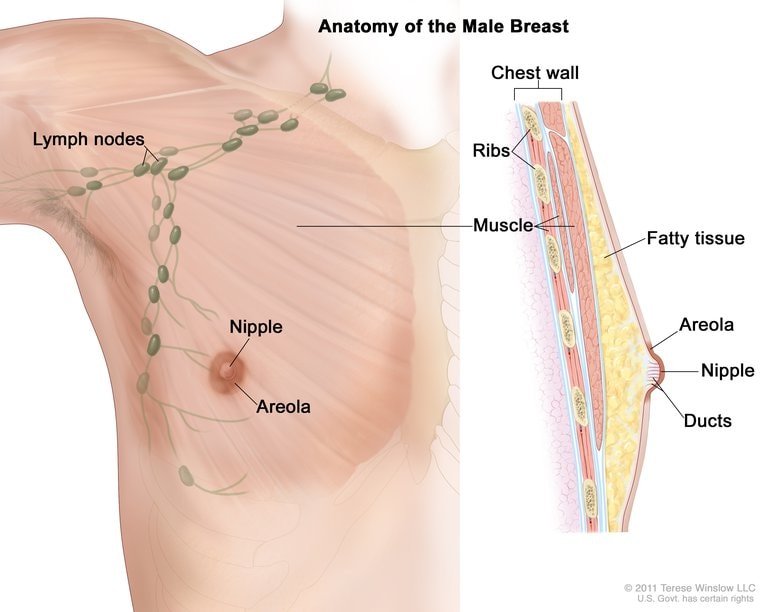Breast Cancer in Men

Anatomy of the male breast. The nipple and areola are shown on the outside of the breast. The lymph nodes, fatty tissue, ducts, and other parts of the inside of the breast are also shown.
© 2011 Terese Winslow LLC. U.S. Govt. has certain rights. Used with permission. Contact artist at www.teresewinslow.com for licensing.
Although it is rare, men can get breast cancer. Learn about symptoms of breast cancer in men and things that may increase your risk.
Breast cancer is most often found in women, but men can get breast cancer too. About 1 out of every 100 breast cancers diagnosed in the United States is found in a man.
The most common kinds of breast cancer in men are—
- Invasive ductal carcinoma. The cancer cells begin in the ducts and then grow outside the ducts into other parts of the breast tissue. Invasive cancer cells can also spread, or metastasize, to other parts of the body.
- Ductal carcinoma in situ (DCIS) is a breast disease that may lead to invasive breast cancer. The cancer cells are only in the lining of the ducts, and have not spread to other tissues in the breast.
What Are the Symptoms?
The most common symptoms of breast cancer in men are—
- A lump or swelling in the breast.
- Redness or flaky skin in the breast.
- Irritation or dimpling of breast skin.
- Nipple discharge.
- Pulling in of the nipple or pain in the nipple area.
These symptoms can happen with other conditions that are not cancer. If you have any symptoms or changes, see your doctor right away.
What Are the Risk Factors?
Several factors can increase a man’s chance of getting breast cancer.
- Getting older. The risk for breast cancer increases with age. Most breast cancers are found after age 50.
- Genetic mutations. Inherited changes (mutations) in certain genes, such as BRCA1 and BRCA2, increase breast cancer risk.
- Family history of breast cancer. A man’s risk for breast cancer is higher if a close family member has had breast cancer.
- Radiation therapy treatment. Men who had radiation therapy to the chest have a higher risk of getting breast cancer.
- Hormone therapy treatment. Drugs containing estrogen (a hormone that helps develop and maintain female sex characteristics), which were used to treat prostate cancer in the past, increase men’s breast cancer risk.
- Klinefelter syndrome. Klinefelter syndrome is a rare genetic condition in which a male has an extra X chromosome. This can lead to the body making higher levels of estrogen and lower levels of androgens (hormones that help develop and maintain male sex characteristics).
- Certain conditions that affect the testicles can increase breast cancer risk.
- Liver disease. Cirrhosis (scarring) of the liver can lower androgen levels and raise estrogen levels in men, increasing the risk of breast cancer.
- Overweight and obesity. Older men who are overweight or have obesity have a higher risk of getting breast cancer than men at a normal weight.
What Can I Do to Reduce My Risk?
If several members of your family have had breast or ovarian cancer, or one of your family members has a known BRCA1 or BRCA2 mutation, share this information with your doctor. Your doctor may refer you for genetic counseling. In men, mutations in the BRCA1 and BRCA2 genes can increase the risk of breast cancer, high-grade prostate cancer, and pancreatic cancer.
If genetic testing shows that you have a BRCA1 or BRCA2 gene mutation, your doctor will explain what you should do to find cancer early, if you get it.
As a neurosurgeon, Don knew everything in life and in surgery is all risk versus benefit. After discovering his family history of breast cancer, he took responsibility for his own health by getting tested and later having an elective mastectomy.
How Is Breast Cancer Treated?
As in women, treatment for breast cancer in men depends on how big the tumor is and how far it has spread. Treatment may include surgery, chemotherapy, radiation therapy, hormone therapy, and targeted therapy. For more information, see the National Cancer Institute’s Male Breast Cancer Treatment.
At 34 years old, Kenneth discovered he had breast cancer. It took an emotional toll on him, but he found strength by connecting with others.
While most fathers and daughters bond over things like dancing or fishing or basketball, Vanessa and her father Arnaldo grew closer when they faced breast cancer treatment together.
- BRCA Mutations: Cancer Risk and Genetic Testing (National Cancer Institute)
- What Is Breast Cancer in Men? (American Cancer Society)